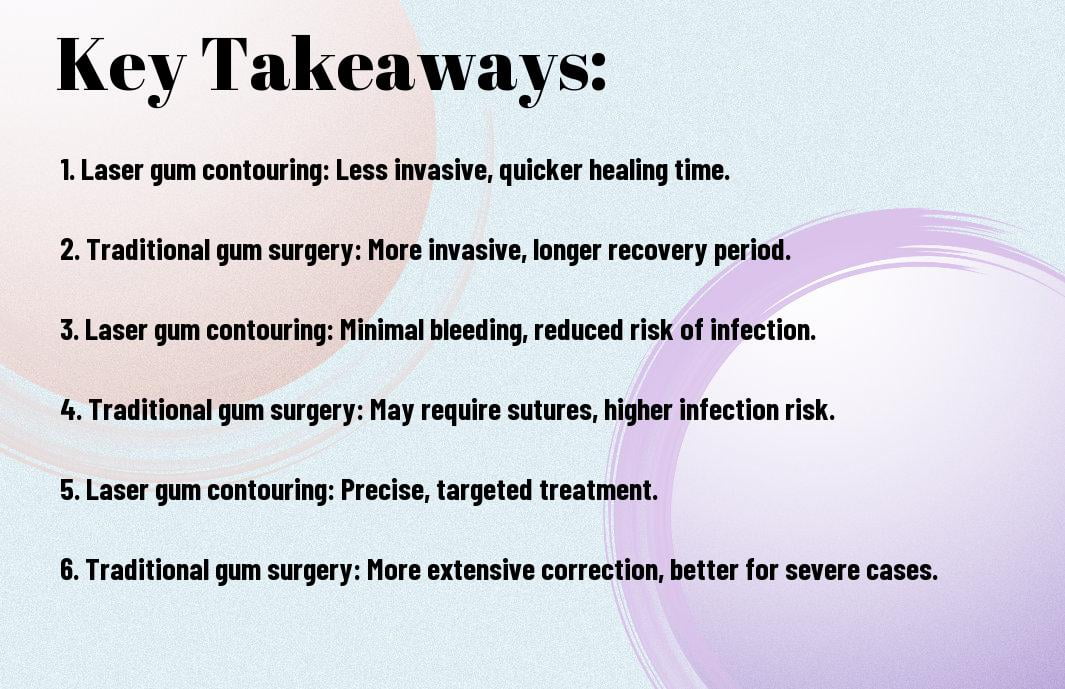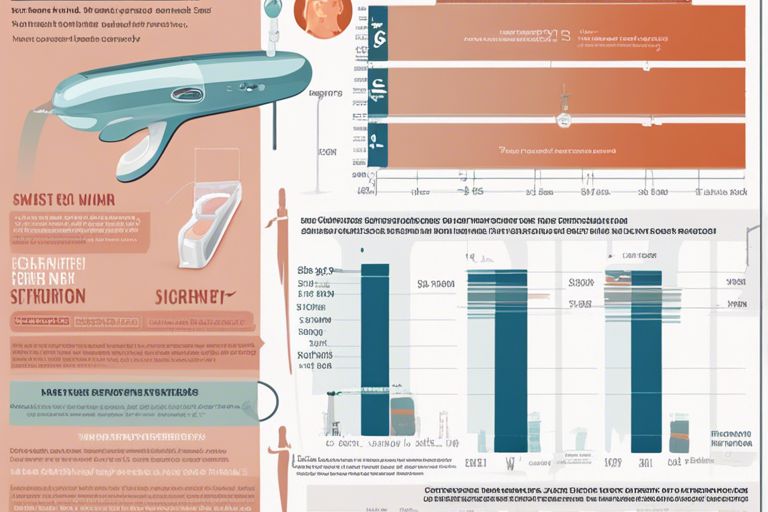With advancements in dental technology, deciding between laser gum contouring and traditional gum surgery can be overwhelming. Your journey to healthier gums and a brighter smile begins with understanding the advantages and disadvantages of each option. Let’s explore into the key differences between the two procedures to help you make an informed decision tailored to your needs.
Key Takeaways:
- Laser Gum Contouring Advantages:
- Less invasive procedure
- Minimal bleeding and swelling
- Faster healing time
- Traditional Gum Surgery Advantages:
- Greater precision for complex cases
- Ability to address deep-rooted issues
- Potentially longer-lasting results
- Overall Considerations:
- Choosing between the two procedures depends on individual needs and case complexity
- Consulting with a dental professional is crucial to determine the most suitable treatment option
- Both procedures have their own set of advantages and disadvantages, making it necessary to weigh the options carefully
What is Laser Gum Contouring?
Before delving into the intricacies of laser gum contouring, it’s necessary to understand what this cutting-edge procedure entails. Laser gum contouring, also known as laser gum reshaping or laser gum surgery, is a minimally invasive cosmetic dental procedure aimed at enhancing the appearance of your smile by sculpting and reshaping the gum line. This advanced technique utilizes state-of-the-art dental lasers to precisely remove excess gum tissue, resulting in a more balanced and aesthetically pleasing smile.
Definition and Procedure
The process of laser gum contouring involves the use of a specialized dental laser that gently vaporizes and sculpts the gum tissue to create a more symmetrical and proportionate gum line. During the procedure, the dentist carefully evaluates your smile and outlines the areas that require reshaping. The laser is then used to precisely target and remove excess gum tissue, resulting in a smoother and more harmonious gum line. Laser gum contouring is a relatively quick and painless procedure that typically requires only one visit to your dentist’s office.
How it Works
Works such as laser gum contouring is a safe and effective alternative to traditional gum surgery, offering numerous benefits for those looking to improve their smile. Unlike traditional gum surgery, which involves incisions and sutures, laser gum contouring is minimally invasive and does not require any cutting or stitching. The precision of the dental laser ensures minimal bleeding and discomfort during and after the procedure, leading to a quicker and more comfortable recovery.
This innovative technique also promotes faster healing and reduces the risk of infection, making it an attractive option for individuals seeking a convenient and hassle-free solution to enhance their smile. The gentle nature of the laser gum contouring procedure allows for greater accuracy and control, enabling your dentist to sculpt your gum line with precision and finesse, leading to natural-looking and long-lasting results.
What is Traditional Gum Surgery?
Definition and Procedure
Traditional gum surgery, also known as gingival flap surgery, is a dental procedure performed to treat various gum diseases, such as periodontitis. During the procedure, your dentist will make incisions in your gum tissue to lift it back and expose the roots of your teeth and the bone supporting them. Your dentist will then remove any disease-causing bacteria and tartar before securely reattaching the gum tissue.
How it Works
One of the main goals of traditional gum surgery is to reduce the depth of gum pockets, which are spaces between the teeth and gums where bacteria can thrive and cause infections. By accessing these pockets and thoroughly cleaning the area, your dentist can help prevent further damage to your teeth and gums.
Another important aspect of traditional gum surgery is to reshape the gum line to create a more aesthetically pleasing smile. This procedure can help improve the overall appearance of your teeth and boost your confidence in your smile.
Advantages of Laser Gum Contouring
Minimally Invasive
After opting for laser gum contouring, you will experience a minimally invasive procedure compared to traditional gum surgery. This means that the laser technology targets only the specific areas requiring treatment, preserving the surrounding healthy gum tissue. As a result, you’ll encounter less discomfort and a reduced need for anesthesia, making the process more comfortable for you.
Reduced Bleeding and Swelling
To enhance your experience further, laser gum contouring offers reduced bleeding and swelling compared to traditional gum surgery. The precision of the laser allows for a much more controlled treatment, minimizing trauma to the gums. As a result, you can expect a quicker recovery time and a more pleasant post-operative experience.
When you choose laser gum contouring, you’re opting for a treatment that promotes a smoother recovery journey. The reduced bleeding and swelling lead to less discomfort, allowing you to resume your daily activities sooner than with traditional gum surgery.
Faster Recovery Time
Any discomfort you may experience after laser gum contouring is typically milder and shorter-lived compared to traditional gum surgery. The minimally invasive nature of the procedure, coupled with reduced bleeding and swelling, contributes to a faster recovery time. You’ll be back to your routine in no time, enjoying the benefits of your newly contoured gums.
For instance, you can expect to return to work or social activities sooner after laser gum contouring due to the faster recovery time. The reduced need for pain medications and shorter healing period make this advanced technique a convenient choice for enhancing your oral health.
Increased Precision
Contouring your gums with a laser provides increased precision that is unmatched by traditional gum surgery methods. The laser can target specific areas accurately, ensuring that only the necessary tissue is treated. This precision results in a more aesthetically pleasing outcome and better overall gum health.
Invasive techniques used in traditional gum surgery are often associated with a higher risk of errors and less predictable results. By choosing laser gum contouring, you benefit from the heightened precision of the laser, ensuring that the contours of your gums are precisely tailored to enhance your smile.
Disadvantages of Laser Gum Contouring
Limited Applicability
Applicability of laser gum contouring may be limited in certain cases where extensive reshaping or bone removal is required. While laser technology is efficient for minor corrections, severe cases of gum overgrowth or complex surgical needs may necessitate traditional gum surgery for optimal results.
Higher Cost
Contouring your gums with a laser may come at a higher price point compared to traditional gum surgery. The advanced technology and specialized training required for laser procedures contribute to the increased cost.
For instance, if you have budget constraints or your insurance does not fully cover the expenses, you may find laser gum contouring financially burdensome compared to the more cost-effective traditional gum surgery.
Potential for Over-Correction
For those considering laser gum contouring, there is a risk of over-correction, leading to asymmetrical gum lines or excessive tissue removal. It is crucial to consult with an experienced periodontist or specialist to avoid complications and ensure the desired outcome.
To prevent over-correction, thorough evaluation and precise planning are necessary before undergoing laser gum contouring. Discuss your aesthetic goals and concerns with your dental provider to achieve a harmonious and natural-looking smile.
Advantages of Traditional Gum Surgery
Established Track Record
For traditional gum surgery, one of the notable advantages is its established track record. Over the years, dentists have been performing various types of gum surgeries with proven success rates. This experience and history provide you with assurance and confidence in the procedure.
Wide Range of Applicability
Established traditional gum surgery techniques can address a wide range of gum issues, from minor cosmetic concerns to more severe periodontal disease. Whether you have receding gums, deep pockets, or other gum-related problems, traditional gum surgery offers customizable solutions to improve your oral health.
Range of applicability is crucial when considering gum surgery options. Traditional gum surgery can be tailored to your specific needs, ensuring that the treatment addresses your individual gum condition effectively. From simple gum reshaping to complex gum disease treatment, traditional gum surgery techniques have the versatility to suit a variety of cases.
Cost-Effective
Wide-ranging applicability of traditional gum surgery also makes it a cost-effective option for improving your gum health. Since these procedures have been in practice for a long time, the costs are often more predictable and standardized compared to newer, cutting-edge treatments. This predictability can help you plan and budget for the procedure with confidence.
Disadvantages of Traditional Gum Surgery
Invasive Procedure
To begin with, traditional gum surgery is an invasive procedure that involves cutting and stitching of gum tissue. You may experience discomfort during and after the surgery due to the invasive nature of the treatment. Additionally, the healing process can be slow and may require multiple follow-up appointments to monitor your progress.
Increased Risk of Complications
For traditional gum surgery, there is an increased risk of complications such as infection, bleeding, and swelling. These risks can prolong your recovery time and may require additional interventions to address. It is important to follow post-operative care instructions diligently to reduce the chances of these complications.
Procedure: During traditional gum surgery, the dentist uses a scalpel to cut away excess gum tissue and reshape the gums to improve their appearance or address underlying issues such as gum disease. This method is effective but comes with a higher risk of complications compared to laser gum contouring.
Longer Recovery Time
Surgery:
The recovery time for traditional gum surgery is longer compared to laser gum contouring. You may experience pain, swelling, and discomfort for an extended period following the procedure. It is crucial to follow all post-operative care instructions provided by your dentist to promote healing and reduce the risk of complications.
The prolonged recovery time associated with traditional gum surgery can impact your daily activities and may require time off work or school to rest and allow your gums to heal properly.
To wrap up
Taking this into account, when comparing Laser Gum Contouring and Traditional Gum Surgery, there are clear advantages and disadvantages to consider. Laser Gum Contouring offers a less invasive approach with minimal pain and faster recovery time, making it a preferred option for many individuals. On the other hand, Traditional Gum Surgery may be necessary for more severe cases that require a more intensive treatment plan.
Ultimately, the choice between Laser Gum Contouring and Traditional Gum Surgery will depend on your individual needs and the recommendation of your periodontist. It’s necessary to weigh the pros and cons of each procedure carefully and consult with your healthcare provider to determine the best course of action for improving the health and appearance of your gums. Recall, maintaining good oral hygiene practices and seeking regular dental check-ups are key factors in preventing gum disease and maintaining overall oral health.
FAQ
Q: What is laser gum contouring and how does it compare to traditional gum surgery?
A: Laser gum contouring is a minimally invasive procedure that uses laser technology to reshape the gum line, while traditional gum surgery involves cutting and suturing the gums. Laser gum contouring is less painful, has a quicker recovery time, and causes less bleeding compared to traditional gum surgery.
Q: What are the advantages of laser gum contouring over traditional gum surgery?
A: Laser gum contouring offers several advantages over traditional gum surgery, including minimal discomfort during and after the procedure, reduced risk of infection due to the cauterizing effect of the laser, and the ability to target specific areas with precision. Additionally, laser gum contouring results in less swelling and shorter healing time, allowing patients to return to their normal activities sooner.
Q: Are there any disadvantages to choosing laser gum contouring over traditional gum surgery?
A: While laser gum contouring is generally seen as a more favorable option, it may not be suitable for all cases. Some disadvantages of laser gum contouring include the need for specialized training and equipment, which may result in higher costs compared to traditional gum surgery. In addition, the effectiveness of laser gum contouring may vary depending on the individual’s specific needs and the severity of their gum issues.







